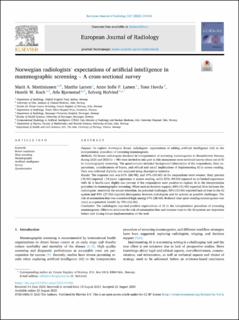| dc.contributor.author | Martiniussen, Marit Almenning | |
| dc.contributor.author | Larsen, Marthe | |
| dc.contributor.author | Larsen, Anne Sofie Frøyshov | |
| dc.contributor.author | Hovda, Tone | |
| dc.contributor.author | Koch, Henrik Wethe | |
| dc.contributor.author | Bjørnerud, Atle | |
| dc.contributor.author | Hofvind, Solveig Sand-Hanssen | |
| dc.date.accessioned | 2024-04-04T08:30:37Z | |
| dc.date.available | 2024-04-04T08:30:37Z | |
| dc.date.created | 2023-09-17T18:22:08Z | |
| dc.date.issued | 2023 | |
| dc.identifier.citation | Martiniussen, M. A., Larsen, M., Larsen, A. S. F., Hovda, T., Koch, H. W., Bjørnerud, A., & Hofvind, S. (2023). Norwegian radiologists’ expectations of artificial intelligence in mammographic screening–A cross-sectional survey. European Journal of Radiology, 167, 111061. | en_US |
| dc.identifier.issn | 0720-048X | |
| dc.identifier.uri | https://hdl.handle.net/11250/3124765 | |
| dc.description.abstract | Purpose
To explore Norwegian breast radiologists’ expectations of adding artificial intelligence (AI) in the interpretation procedure of screening mammograms.
Methods
All breast radiologists involved in interpretation of screening mammograms in BreastScreen Norway during 2021 and 2022 (n = 98) were invited to take part in this anonymous cross-sectional survey about use of AI in mammographic screening. The questionnaire included background information of the respondents, their expectations, considerations of biases, and ethical and social implications of implementing AI in screen reading. Data was collected digitally and analyzed using descriptive statistics.
Results
The response rate was 61% (60/98), and 67% (40/60) of the respondents were women. Sixty percent (36/60) reported ≥10 years’ experience in screen reading, while 82% (49/60) reported no or limited experience with AI in health care. Eighty-two percent of the respondents were positive to explore AI in the interpretation procedure in mammographic screening. When used as decision support, 68% (41/60) expected AI to increase the radiologists’ sensitivity for cancer detection. As potential challenges, 55% (33/60) reported lack of trust in the AI system and 45% (27/60) reported discrepancy between radiologists and AI systems as possible challenges. The risk of automation bias was considered high among 47% (28/60). Reduced time spent reading mammograms was rated as a potential benefit by 70% (42/60).
Conclusion
The radiologists reported positive expectations of AI in the interpretation procedure of screening mammograms. Efforts to minimize the risk of automation bias and increase trust in the AI systems are important before and during future implementation of the tool. | en_US |
| dc.language.iso | eng | en_US |
| dc.publisher | Elsevier | en_US |
| dc.rights | Navngivelse 4.0 Internasjonal | * |
| dc.rights.uri | http://creativecommons.org/licenses/by/4.0/deed.no | * |
| dc.title | Norwegian radiologists’ expectations of artificial intelligence in mammographic screening – A cross-sectional survey | en_US |
| dc.type | Peer reviewed | en_US |
| dc.type | Journal article | en_US |
| dc.description.version | publishedVersion | en_US |
| dc.rights.holder | The authors | en_US |
| dc.subject.nsi | VDP::Medisinske Fag: 700 | en_US |
| dc.source.volume | 167 | en_US |
| dc.source.journal | European Journal of Radiology | en_US |
| dc.identifier.doi | 10.1016/j.ejrad.2023.111061 | |
| dc.identifier.cristin | 2175818 | |
| cristin.ispublished | true | |
| cristin.fulltext | original | |
| cristin.qualitycode | 1 | |

